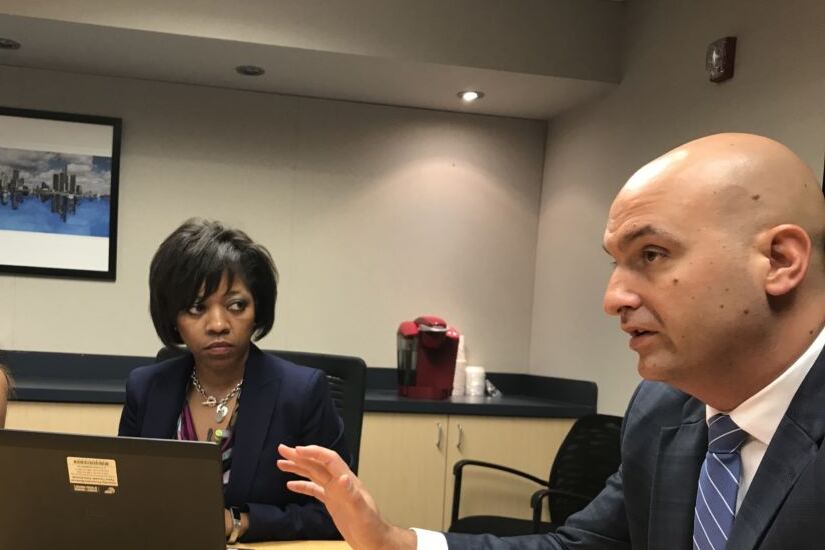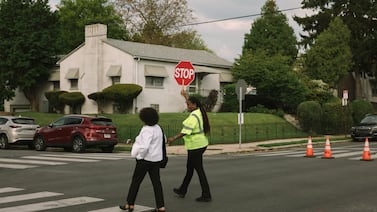Cafeterias and auditoriums would become classrooms. Classes would have no more than 20 students. Students would be screened daily for COVID-19 symptoms. High school students might attend school on alternating weeks, and tune in to class virtually the rest of the time.
Schedules would also be simplified to provide an increased focus on literacy, math, and other core classes.
This is what school could look like in the Detroit school district when classes resume in the fall, according to a draft reopening plan sent to all district employees on Friday.
“This is our best thinking,” Superintendent Nikolai Vitti said. “This isn’t released on the assumption that we’ve gotten everything right. It’s more about putting the idea out there and being comfortable with feedback and pushback.”
Click here to read the full draft plan.
A final plan, based on feedback the district receives through virtual meetings with parents, students, staff and others, will be released later this month.
School districts statewide are developing plans for returning to school after months of building closures due to the coronavirus. A 26-member state task force, appointed by Gov. Gretchen Whitmer, will make recommendations for a healthy and safe return to schools.
Vitti said the draft plan, which also covers summer school, was developed using federal guidelines from the Centers for Disease Control and the Occupational Health and Safety Administration, recommendations from the American Federation of Teachers, and the state’s Safe Start plan, which state officials are using to determine when to reopen the economy.
The plan was built around some important budget realities. The Detroit district is receiving $85 million from the CARES Act, a coronavirus relief bill that included $13.5 billion for schools. Michigan received $390 million. At the same time, districts across the state are facing what some top officials say will be the worst education budget cut in state history, and additional federal help is far from guaranteed.
He said the district is considering reducing the school day to about 6 hours. Currently, the school day runs about seven hours a day. A six-hour day, Vitti said, “is the minimum hours a day to meet the state requirement based on 181 calendar days of school.” The shorter day would mean less time in a school building for people to get sick.
Schedules will likely be simplified to provide more emphasis on literacy, mathematics and core classes.
The plan includes three scenarios for reopening in the fall.
Elementary and middle school students would have in-person classes daily, but with a number of social distancing measures in place.
High school students would be in a school building on alternate weeks. For teachers, this means half of their students would be at home, watching lessons unfold online, while the other half is there in person. The next week, those who were in school the previous week would be learning at home.
The district would also provide full-time virtual lessons for students, though Vitti said the state would need to provide flexibility for districts to count those as days of instruction.
Online instruction will be easier in the district after a big fundraising effort raised enough money to purchase tablets for every student in the district. Those devices, as well as internet access, will be handed out beginning sometime this month.
Vitti said the district opted to only consider an alternate week schedule for high school students. He said it’s not a realistic option for younger students because parents who work can’t be home with their children on those weeks when they’re not in the school building.
“High school students are at an age where they can be at home by themselves,” Vitti said.
He said auditoriums and cafeterias would be used more frequently as classroom spaces because the larger spaces would make social distancing easier. And the number of students in each class, which he said would top out at 20, would vary by school depending on factors such as room sizes.
The plan also includes a number of safety precautions. Students and staff would be provided with personal protective equipment, such as masks and face guards. Each teacher would be given disinfectant wipes, portable hand sanitizer dispensers will be available, and the district will install plexiglass barriers at frequently visited spaces.
He said parents in the district fall into three camps: those who don’t want their kids in school at all and prefer online classes, those who want their kids in school every day, and those waiting to see how things improve or regress to make up their minds.
Mariana Hernandez isn’t sure the district’s plan will work. Her two children attend Maybury Elementary School and Clippert Multicultural Magnet Honors Academy, where some classrooms lack the windows and air conditioning necessary for proper ventilation.
“If they can assure that our kids will be safe, I’m okay with” sending my kids back to school, she said, speaking in Spanish. “But I doubt they can do that.”
Hernandez says she’s spent the last couple of months “battling” with her children as they try to keep up with their classwork online, but she says she is still looking into home schooling them next fall. She is in the minority, although not by much: 61% of the 4,000 parents who responded to a district phone survey said they’d be comfortable sending their child back to a school building in the fall.
Teachers were less sure. About 50% of them in the survey say they are ready to return to the classroom.
Carrie Russell, a Cody High School math teacher, appreciates the district’s efforts to put together a plan for the community to review, but she’s concerned about having to teach virtually and in person in the fall, with an emphasis on core subjects.
“I want students to be successful, but I don’t know how we would actually pull it off in two months,” she said. “Students come to school for more than academics … I’m worried we’ll lose student engagement.”
As part of the plan, district staff will be required to have a negative COVID-19 test result before returning to in-person work, and complete health and safety training under the proposed reentry plan. Students would also be trained in hand-washing and respiratory hygiene.
Detroit Federation of Teachers president Terrence Martin said he hasn’t had a chance to thoroughly study the plan’s details yet, but said that union leaders were supposed to receive the draft plan before its public release to offer suggestions and negotiate work terms and conditions. A letter of agreement with the union will also be required, Martin said, around what work will look like for the union, which represents teachers, counselors and other district staff.
“We look forward to negotiating the terms and conditions of both summer school and regular school next week, when we meet with the school district,” he said.
In response, Vitti said that while district leaders look forward to collaborating with unions about the reopening plan, the general plan and strategy aren’t matters of collective bargaining.
“Surely, if there are changes to schedules, lunches, and/or prep times then those matters will be negotiated.”







